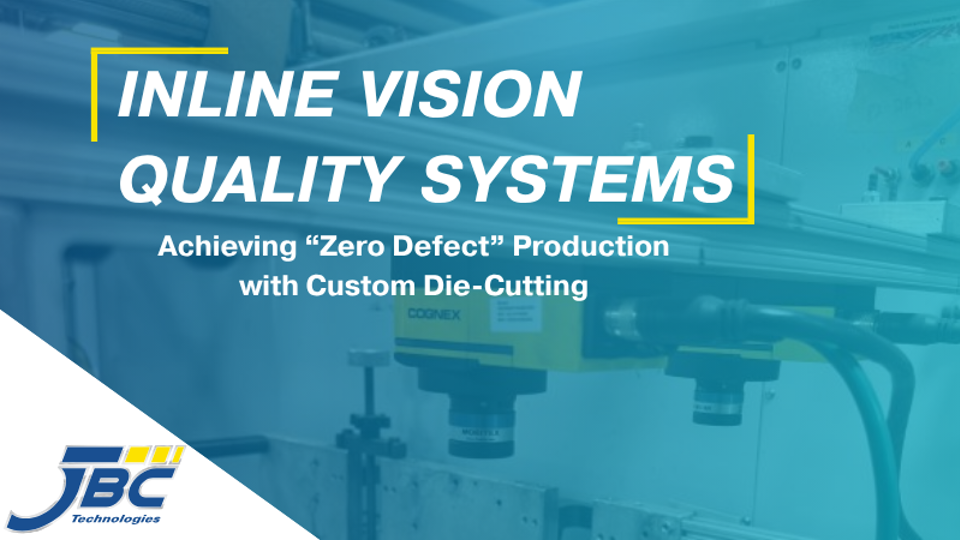Inline Vision Quality Systems: Achieving "Zero Defect" Production with Custom Die-Cutting

Defects come in all shapes and sizes...
From bubbles and blemishes to tears or missing features, defects in die-cut components can be hard to spot until it's too late. For high-risk components in aerospace, medical, and EV battery applications, even the smallest defect can equal costly redesigns, production setbacks, and product failures. While catching these defects is important, catching them early is absolutely critical.
In-line vision defect detection systems are a crucial part of a converting partners' quality management system. By leveraging multiple high-resolution cameras, these systems inspect every part produced on high-speed rotary die-cutting machines. Surveying for defects in real time, vision systems allow for instantaneous defect detection, process adjustments, and traceability for quality audits. When quality is non-negotiable, working with a converting partner whose quality management system matches your commitment to excellence is essential.
Let’s take a closer look at how JBC’s inline vision quality management system works...
Optimizing Quality with a Good, Better, Best System
JBC's comprehensive inline vision quality system takes a three-tiered approach, or as we call it a “good, better, best” system. By assessing the risk and application of each part, JBC develops a custom quality plan tailored to each project's specific needs. Each tier is cumulative, meaning as each tier increases, you retain all of the features of the previous tier.
|
|
Tier 1: Presence/Absence AnalysisThis first tier follows a robust yet efficient management system. For lower-risk components, like non-critical gaskets where cleanliness is less of a concern, JBC implements a system based on pattern recognition, verifying part counts, and performing a presence/absence analysis. Think of this tier as a gut-check, keeping track of how many parts are made and making sure none are missing any critical design features. |
|
|
Tier 2: Verifying Part DimensionsTier 2 adds another level of precision to the process. For higher-risk components, a more advanced system goes beyond identifying crucial design features to measure the parts' dimensions in real time. In this tier, every component is checked to ensure that they are dimensionally sound, catching even the slightest deviations. For tight tolerance components that must meet exact sizes in order to function properly this is critical for catching parts with even the slightest dimensional deviation. |
|
|
Tier 3: Any Defect, AnywhereTier 3 is the most stringent, all-encompassing level of defect detection. For this tier, an AI-driven “any defect, anywhere” system learns what a “good part” looks like and flags any deviations including scratches, dents, surface contamination, or bubbles. The AI's machine learning capabilities allow it to apply contextual logic, distinguishing between acceptable variations and true defects. For example, in a flexible membrane for a medical device, bubbles under a certain size may not affect part quality or performance. The AI can be trained to flag only the bubbles that exceed the given size, ignoring those deemed harmless. This system excels in high-volume production runs, as the AI continually gets smarter after each part it examines. All of this quality data can then be exported to a server for lot tracing and quality audits. |
JBC Technologies: A Partner in Quality and Performance
Quality management is not one size fits all. Assessing each project's individual quality needs and developing a custom solution is the key to achieving “zero defect” production. Choosing a converting partner that takes quality as seriously as you do is an important first step to a successful die-cutting project...
JBC Technologies is an ISO 9001 and ISO 13485 Certified die-cutter and flexible materials converter with over 35 years of experience engineering custom die-cut solutions for the medical, aerospace, energy storage, industrial, and automotive industries. With a team of degreed engineers and relationships with industry-leading suppliers, JBC leverages materials and process engineering expertise to convert films, foils, foams, papers, plastics, and fabrics into functional components. Founded on the pillars of supply chain optimization, engineering innovation, and manufacturing excellence, JBC provides full product life-cycle support, from small volume prototyping to high-volume manufacturing.



